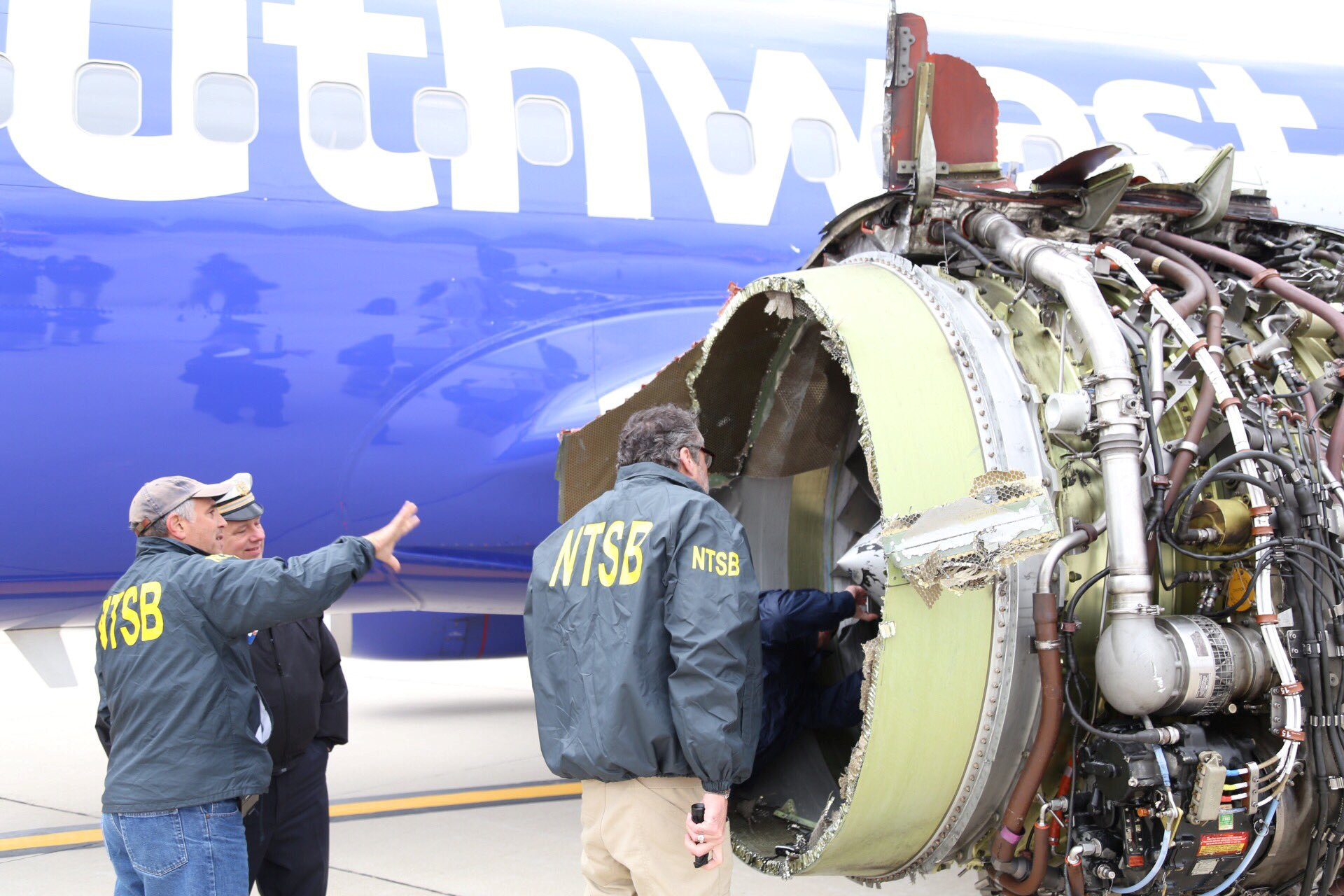

Bank executive Jennifer Riordan (43) was killed when she was partially pulled through a shattered window next to her seat in row 14 as the cabin suffered rapid decompression. Fellow passengers were able to pull her back inside but she died of her injuries later on Tuesday.
Seven other people were treated for injuries.
Videos posed on social media showed passengers grabbing for oxygen masks and screaming as the plane, piloted by 56-year-old Tammie Jo Shults, a former fighter pilot for the US Navy, prepared for its descent into Philadelphia.
Federal air safety officials investigating why the CFM56 engine blew apart said on Wednesday that the incident began when a fan blade already suffering metal fatigue snapped off in mid-flight.
The US Federal Aviation Administration said on Wednesday it would order inspection of some 220 jet engines. The order, called an air-worthiness directive, would require an ultrasonic inspection within the next six months of the fan blades on all CFM56-7B engines that have accrued a certain number of flights.
National Transportation Safety Board Chairman Robert Sumwalt told a news conference that he could not yet say if the incident, the first deadly airline accident in the United States since 2009, pointed to a fleet-wide issue in the Boeing 737-700.
"We want to very carefully understand what was the result of this problem, and as I mentioned a few minutes ago, I’m very concerned about this particular event," Sumwalt said at the news conference at the Philadelphia airport. "To be able to extrapolate that to the entire fleet, I’m not willing to do that right now.”
A National Transportation Safety Board inspection crew was also combing over the Boeing 737-700 for signs of what caused the engine to explode.

Sumwalt said the fan blade, after suffering metal fatigue where it attached to the engine hub, suffered a second fracture about halfway along its length. Pieces of the plane were found in rural Pennsylvania by investigators who tracked them on radar. The metal fatigue would not have been observable by looking at the engine from the outside, Sumwalt said.
European regulators earlier this month ordered checks following lengthy analysis of a similar non-fatal incident at Southwest two years ago, but investigators warned it was too early to say whether the two problems were linked.
French accident investigators said on Wednesday they were sending a team to assist the investigation led by the Washington-based National Transportation Safety Board because the engine was developed by a French-US joint venture, CFM International.
France's Safran, which co-produces the engines along with General Electric, would also provide technical support, a spokesman for the BEA air accident agency added.
All recent Boeing 737s are powered by engines from CFM, a workhorse of the global airlines that has logged more than 350 million hours of safe travel but some of which were also being examined after the 2016 accident.
CFM said there were more than 8000 of its CFM56-7B engines in operation on Boeing 737 passenger jets.

METAL FATIGUE
Although no cause has been ruled out, the first fatal US airline accident since 2009 was expected to focus attention on the role of metal fatigue in engine accidents, which are rare.
An early review of Tuesday's failed Southwest engine found preliminary evidence of metal fatigue where a fan blade had broken off, Robert Sumwalt, chairman of the US National Transportation Safety Board (NTSB), told reporters on Tuesday.
In August 2016, a Southwest flight made a safe emergency landing in Pensacola, Florida, after a fan blade separated from the same type of engine, and debris ripped a foot-long hole above the left wing. There too, investigators cited signs of metal fatigue.
"We are very concerned," the NTSB's Sumwalt said, referring to the overall challenge of detecting slow-developing metal fatigue.
"There needs to be proper inspection mechanisms in place to check for this before there's a catastrophic event."
Completing the latest investigation will take about 12-15 months, he said.
ENGINE CHECKS
Southwest said it was speeding up inspections of all related engines, which it expected to complete within 30 days.
A person with knowledge of the situation said the airline was not inspecting all of its CFM56 engines, instead focusing on older ones - some 400 to 600 in total.
Investigators said on Tuesday they would be examining maintenance records of the airline, which operates one of the world's largest 737 fleets and has a strong safety record.
The 2016 incident prompted the US Federal Aviation Administration (FAA) to propose ultrasonic inspections of similar fan blades and their replacement if needed.
Sumwalt said the NTSB would review whether the engines involved in Tuesday's incident might have been subject to that directive, which is not yet finalised.
European regulators, meanwhile, this month began requiring an inspection by early next year following a bulletin to airlines issued by CFM itself after the 2016 incident.
A person familiar with the matter said US regulators were close to finalising a similar rule.
Korean Air Lines Co Ltd said it planned to carry out voluntary inspections of engines used on its entire 737 fleet by November.
About 20-30% of its 35 Boeing 737 jets use the same type of fan blade as the one on the Southwest jet.
Japan Airlines said two 737 jets in its fleet had engines with affected fan blades and inspections were due to be completed on Wednesday.
Ireland's Ryanair, Europe's largest 737 operator, said fewer than 70 of its 440 planes were fitted with identical CFM56-7B engines and that all had been inspected.
In Canada, WestJet Airlines said it planned to accelerate inspections of certain fan blades, while in Dubai, budget carrier flydubai said it had implemented the European directive ahead of the deadline.
The US FAA has estimated that checks would require two hours per inspection.
Not all airlines operating 737s were affected.











